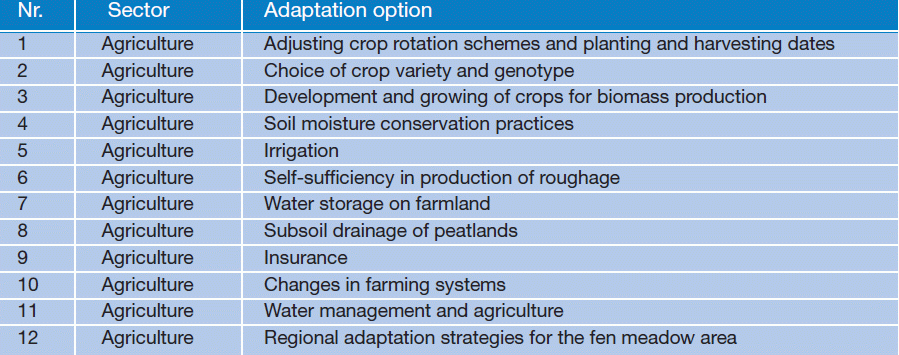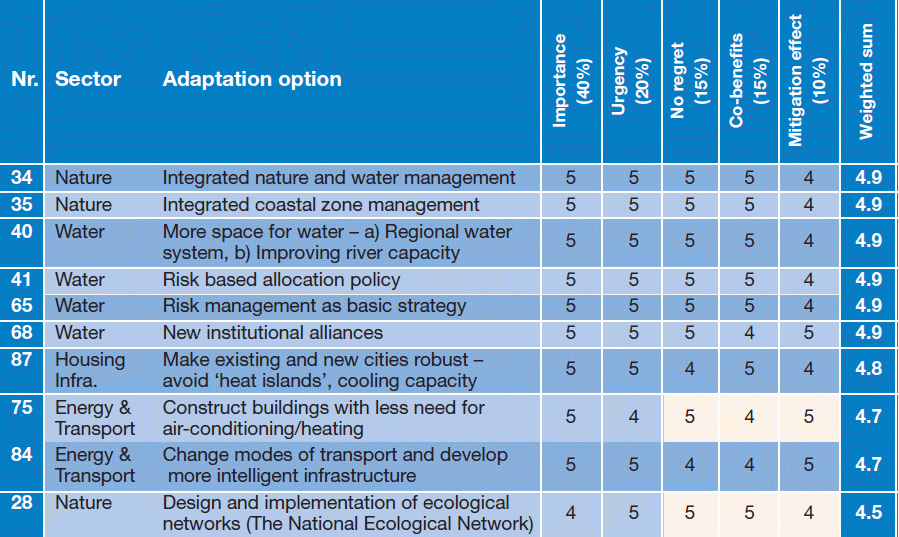
Technical Policy Briefing Notes - 6
Multi-Criteria Analysis
Case Studies
Policy Briefs
Multi-Criteria Analysis
Case Studies
The MEDIATION study has reviewed existing
literature examples that have applied Multi-
Criteria Analysis to adaptation.
The review has found several relevant applications. This includes application at the national level, for early programmatic analysis of adaptation as part of national strategy development (see case study box below).
It also includes the application of MCA to complement economic appraisal of adaptation at the project level (e.g. EA, 2009), to allow the analysis of a broader set of criteria, particularly environmental and social aspects.
The review has found several relevant applications. This includes application at the national level, for early programmatic analysis of adaptation as part of national strategy development (see case study box below).
It also includes the application of MCA to complement economic appraisal of adaptation at the project level (e.g. EA, 2009), to allow the analysis of a broader set of criteria, particularly environmental and social aspects.
Box
1. MCA for Adaptation in the Netherlands
An example of a multi criteria analysis for adaptation in the Netherlands is summarised, based on De Bruin et al. (2009) and Van Ierland et al. (2007).
The analysis started with a typical climate change scenario developed by the Royal Netherlands Meteorological Institute for the period up to 2050 (KNMI, 2006). Adaptation options were identified in workshops for different sectors, namely agriculture, nature, water, energy & transport, housing & infrastructure, health, and recreation and tourism. Experts on spatial planning and adaptation to climate change as well as public and private stakeholders were involved in the identification and ranking of the adaptation options, including representatives from different research institutes, NGOs, universities and Ministries.
The next step was to score and weight these adaptation options. The options (see Table 3 for examples for the agricultural sector) were given scores with respect to the following priority criteria (See Table 4):
Table 3. Examples of adaptation options for the agricultural sector (based on literature survey and stakeholder consultation).


The importance (i.e. effectiveness in avoiding damages) of an option reflects the level of necessity to implement the option so as to avoid negative impacts. These options can reduce major damages related to climate change. In principle they generate substantial gross benefits (avoided damages), though potentially at high costs.
The urgency of the option relates to the need of implementing the adaptation option immediately or whether it is possible to defer action to a later point in time. Investments with a long lead time, or investments that have a long life time and conservation of the current situation require early action, and therefore potentially a long delay before implementing the option will make it redundant, much more costly or even impossible. Note that a high score on urgency does not necessarily imply that the option deserves a very high final ranking. It only indicates that postponing action may result in higher costs or irreversible damage.
Table 4. The top ten options for the Netherlands based on ranking with criteria weighting for importance, urgency, no regret, co-benefits and mitigation effect – high scores indicate high priority

Note: high scores indicate high priority to implement the option. Weighted sum of scores for other options are given in Table 6 of De Bruin et al. (2009)
In assessing the economic characteristics of various adaptation options a distinction is made between no-regret options and options with co-benefits. No-regret options are the adaptation options for which non-climate related benefits, such as improved air quality, will exceed the costs of implementation; hence they will be beneficial irrespective of future climate change taking place.
The United Kingdom Climate Impacts Programme (Willows and Connell, 2003) has defined no-regret adaptation options (or measures) as: “options (or measures) that would be justified under all plausible future scenarios, including the absence of human-induced climate change”. A no-regret option could be one that is worthwhile, in that it would yield economic and environmental benefits which exceed its cost, and will continue to be worthwhile, irrespective of any benefits of avoided climate damages.
Options that score high on the criterion co-benefit are specifically designed to reduce climatechange related vulnerability while also producing corollary benefits that are not related to climate change (Abramovitz et al., 2002). Co-benefits thus concern external effects which have a positive impact on policy goals unrelated to climate change policy (Metroeconomica, 2004).
Finally, the options were scored according to their effect on mitigation. Certain adaptation options also induce a reduction of greenhouse gas emissions, and thus score very high on mitigation effect (i.e. are strengthening mitigation policies), while other adaptation options actually increase greenhouse gas emissions. Scores were attached for each of the options and for each of the criteria, ranging from 1-5, indicating very low priority (1) to very high priority (5).
To assess the political feasibility of the adaptation options, the options were also ranked according to their complexity, for three categories of complexity: (i) Technical, (ii) Social and (iii) Institutional complexity. This results in a ranking for complexity, which enables policymakers to consider the complications that may arise in the implementation of the adaptation options (See Table 5).
Table 5. Top 10 of complex options: Scoring and ranking of adaptation options regarding feasibility – high scores indicate highest complexity.

Note: high scores indicate high complexity to implement the option, i.e. low feasibility. Weighted sum of scores on complexity for other options are given in Table 6 of De Bruin et al. (2009)
An example of a multi criteria analysis for adaptation in the Netherlands is summarised, based on De Bruin et al. (2009) and Van Ierland et al. (2007).
The analysis started with a typical climate change scenario developed by the Royal Netherlands Meteorological Institute for the period up to 2050 (KNMI, 2006). Adaptation options were identified in workshops for different sectors, namely agriculture, nature, water, energy & transport, housing & infrastructure, health, and recreation and tourism. Experts on spatial planning and adaptation to climate change as well as public and private stakeholders were involved in the identification and ranking of the adaptation options, including representatives from different research institutes, NGOs, universities and Ministries.
The next step was to score and weight these adaptation options. The options (see Table 3 for examples for the agricultural sector) were given scores with respect to the following priority criteria (See Table 4):
- the importance of the option in terms of the expected gross benefits that can be obtained;
- the urgency of the option, reflecting the need to act soon and not later;
- the no-regret characteristics of the option (it is good to implement, irrespective of climate change);
- the co-benefits to other sectors and domains; and
- the effect on climate change mitigation (for instance through changes in land-use that reduce emissions of greenhouse gases as a side effect).
Table 3. Examples of adaptation options for the agricultural sector (based on literature survey and stakeholder consultation).


The importance (i.e. effectiveness in avoiding damages) of an option reflects the level of necessity to implement the option so as to avoid negative impacts. These options can reduce major damages related to climate change. In principle they generate substantial gross benefits (avoided damages), though potentially at high costs.
The urgency of the option relates to the need of implementing the adaptation option immediately or whether it is possible to defer action to a later point in time. Investments with a long lead time, or investments that have a long life time and conservation of the current situation require early action, and therefore potentially a long delay before implementing the option will make it redundant, much more costly or even impossible. Note that a high score on urgency does not necessarily imply that the option deserves a very high final ranking. It only indicates that postponing action may result in higher costs or irreversible damage.
Table 4. The top ten options for the Netherlands based on ranking with criteria weighting for importance, urgency, no regret, co-benefits and mitigation effect – high scores indicate high priority

Note: high scores indicate high priority to implement the option. Weighted sum of scores for other options are given in Table 6 of De Bruin et al. (2009)
In assessing the economic characteristics of various adaptation options a distinction is made between no-regret options and options with co-benefits. No-regret options are the adaptation options for which non-climate related benefits, such as improved air quality, will exceed the costs of implementation; hence they will be beneficial irrespective of future climate change taking place.
The United Kingdom Climate Impacts Programme (Willows and Connell, 2003) has defined no-regret adaptation options (or measures) as: “options (or measures) that would be justified under all plausible future scenarios, including the absence of human-induced climate change”. A no-regret option could be one that is worthwhile, in that it would yield economic and environmental benefits which exceed its cost, and will continue to be worthwhile, irrespective of any benefits of avoided climate damages.
Options that score high on the criterion co-benefit are specifically designed to reduce climatechange related vulnerability while also producing corollary benefits that are not related to climate change (Abramovitz et al., 2002). Co-benefits thus concern external effects which have a positive impact on policy goals unrelated to climate change policy (Metroeconomica, 2004).
Finally, the options were scored according to their effect on mitigation. Certain adaptation options also induce a reduction of greenhouse gas emissions, and thus score very high on mitigation effect (i.e. are strengthening mitigation policies), while other adaptation options actually increase greenhouse gas emissions. Scores were attached for each of the options and for each of the criteria, ranging from 1-5, indicating very low priority (1) to very high priority (5).
To assess the political feasibility of the adaptation options, the options were also ranked according to their complexity, for three categories of complexity: (i) Technical, (ii) Social and (iii) Institutional complexity. This results in a ranking for complexity, which enables policymakers to consider the complications that may arise in the implementation of the adaptation options (See Table 5).
Table 5. Top 10 of complex options: Scoring and ranking of adaptation options regarding feasibility – high scores indicate highest complexity.

Note: high scores indicate high complexity to implement the option, i.e. low feasibility. Weighted sum of scores on complexity for other options are given in Table 6 of De Bruin et al. (2009)
 download this briefing note
download this briefing note